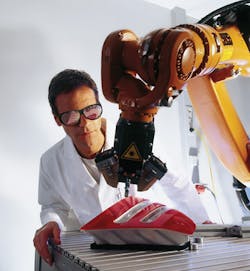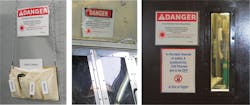Laser Safety: New ANSI guidelines remind users to take stock of industrial laser protections
GEOFF GIORDANO
Now more than ever, the concept and practice of laser safety is a moving target. More job shops are embracing laser technology to produce or repair all sorts of parts, which means employers must protect laser operators by ensuring they receive up-to-date training and the right protective equipment. For example, advances in laser-based medical procedures might require new usage guidelines for healthcare personnel.
The just-revised American National Standards Institute (ANSI; Washington, DC) Z136.1 parent standard for the safe use of lasers acknowledges the fluidity of the technology, noting that "it is expected that this standard will be periodically revised as new information and experience in the use of lasers are gained." Such new information led to the creation of the ANSI Z136.9 standard for the safe use of lasers in manufacturing, first issued in 2013.
"The advent of really high-powered fiber lasers and the potential for femtosecond and picosecond lasers in actual manufacturing operations has increased the need for safety attention," says Tom Lieb, chair of the Z136.9 committee and president of L A I International (Elk Grove, CA). Fiber lasers have enhanced the growth of an array of applications due to their relatively lower cost, plug-and-play capability and low use of floor space, he says.
In particular, major automotive companies have raised the bar on safety consciousness in the past five years, Lieb notes. They have "put protocols in place that demonstrate their awareness of safety concerns for lasers in the workplace and put requirements on their suppliers that heretofore hadn't existed."
In the research realm, 'home-brewed' lasers will continue to present challenges. "Research settings are more fluid" than industry or medicine, says Ken Barat, chairman of the technical committee responsible for writing the ANSI Z136.8 standard "Safe Use of Lasers in Research, Development, or Testing," first issued in 2012. "In industry, once the controls are in place, things are pretty much set for long periods of use. In medical settings, people work off a checklist for each procedure. In R&D, a setup can stay the same with just different samples for years or change every few weeks, following the path of the results or funding."
Where to start
Gus Anibarro, education director for the Laser Institute of America (LIA), suggests a series of steps for establishing a safe laser environment:
First, determine the class of your laser and its nominal hazard zone. That will dictate the kind of safety program you need, with Class 3B and Class 4 lasers requiring the most protections (see Fig. 1).
Next, create a laser safety program based on the recommendations of the ANSI Z136 guidelines appropriate for your organization.
Then, determine whether or not you must name a laser safety officer (LSO). For example, if you have a Class 4 laser system with minimal laser-safe guarding, an LSO will be required. If you use a Class 3B laser for measuring and sensing on a production line, the beam is likely to be open, requiring an LSO. However, a Class 3R or lower sensing laser will not require an LSO. Even if you only have a Class 1 laser system with an embedded Class 4 laser, you will need an LSO if you hire someone to service and align the system by removing a portion of the enclosure or defeating the interlocks. And if your LSO leaves your company, be sure to name another one immediately, lest your well-crafted laser safety plan lapse.
Also vital is to train your LSO. This person, who is likely to wear many hats in the organization, must be able to analyze laser hazards, implement control measures (proper signage, laser-safe curtains, and barriers) and continually monitor the safety program. In some cases, the LSO will have to be trained to calculate the hazard zone for one or more laser systems. Also, train other laser users as required. Online courses offered by LIA allow LSOs to train many operators at different sites without sending them to a classroom.
Finally, consider an audit of your laser safety program by an outside consultant six months to a year after it has been in place. Anibarro notes that he has on occasion discovered lasers that were unaccounted for during audits he has conducted. "I might find out they have a Class 4 used for marking product codes," Anibarro says. "When I go in there to look at the laser welder, they forget that they had a marking laser. It's the same in hospitals; we find a laser they didn't know they had because a sales rep was loaning it to the hospital. It wasn't a rental laser; the hospital didn't own it; and the LSO was unaware until I showed up." At one production facility, he recalls, "they had a punch press, an arc welding machine, a water jet machine, and then the laser-and you didn't know what it was unless you worked there."
Rules and regulations
While the ANSI Z136 standards are merely guidelines—and not mandatory—they are often used to create rules that are mandatory and could cost your operation plenty of money in fines or injury lawsuits. "While there is considerable compatibility among existing laser safety standards, some requirements differ among state, federal and international standards," the ANSI Z136.1 advises. "These differences may have an effect on the particulars of the applicable control measures."
Since 2005, LIA has provided laser-safety information and trained OSHA compliance officers as part of the OSHA Alliance Program. "If you have a Class 3B or 4 laser and OSHA inspects your facility and finds you don't have a laser safety officer, they could cite you under the general duty clause," Anibarro cautions. "I've walked into places that didn't have laser safety officers but did have a laser safety program in place, but because there wasn't an LSO, nobody was really following the safety program," Anibarro recalls. "So they got paid a visit by OSHA as a consequence of an accident."
Likewise, facilities using lasers can run afoul of widely divergent state regulations. Some states mandate that an LSO be in place where Class 3B and 4 lasers are present, while also requiring those lasers to be registered.
In terms of safety signage, the new Z136.1 grandfathers in what a facility had been using prior to the 2014 revision. However, the new standard introduces a "warning" sign and explains how to use it in addition to the prior "caution," "danger," and "notice" signs (see Fig. 2).Beam and non-beam hazards
From fires in a patient's airway during surgery to exploding gas canisters, not to mention serious eye and skin burns, the consequences of unsafe laser use can be dire. In his 15 years with the LIA, Anibarro has even heard of amputations when people have accidentally put their hand in the path of a beam. "I have heard of people getting a best-buy date marked right into their forearm," he recalls.
In his basic laser course at LIA's annual Lasers for Manufacturing Event, Anibarro discusses the various levels of retinal and corneal damage or skin burns laser users can suffer. Unexpected threats can cause sudden harm: from direct exposure to a Class 4 laser in a Class 1 enclosure that has been breached for some reason, like maintenance; from calibrating an aiming beam on a robotic system; or from a laser reflecting off a specular (mirror-like) surface. However, sometimes a diffuse (rough) surface can present a hazard.
"If the wavelength of the laser is longer than the distance between the peaks in the material," Anibarro notes, "then the surface may appear specular (to the laser). The laser that always comes to mind is the CO2; you have a very long wavelength relative to the Nd:YAG, and what may appear to be a rough surface to the human eye for that specific wavelength might be highly specular. So if you are cutting through mild or carbon steel, that surface may look somewhat dull" but reflect a dangerous beam.
Quite often, basic laser injuries either go unreported or aren't viewed as worthy of note. While teaching a class, Anibarro remembers a technician who swore he'd never suffered an eye injury but revealed that he had sustained many burns on his arms and hands. In another case, employees at a facility were often burned when putting their hands into laser chambers to hold material being welded. "Minor as it may be, that is still considered an incident," says Anibarro.
Lasers can also generate airborne contaminants when interacting with materials or create hazardous plasmas. "Plasma gives off wavelengths from 180 to 550 nm," Anibarro says. Eyewear to protect against those plasma emissions should have an optical density (OD) of 2 or 3, he adds, but operators must remember that those OD ratings won't necessarily protect them against the laser.
The primary control measure to remove toxic airborne substances is exhaust ventilation. "If you're cutting into steel or some kind of plastic or polymer, or even biological tissue, you want to evacuate it," Anibarro cautions. "Respiratory protection is only for temporary use."
Ultimately, it is up to those purchasing lasers for their business to know when to employ a laser safety officer, and it's up to a laser safety officer to know the latest guidelines for protecting laser operators, repair personnel, and any other individuals who might be in the vicinity of a Class 3B or 4 laser. The latest ANSI Z136.1, Z136.8, and Z136.9 standards are critical for your laser safety toolbox.
Geoff Giordano is media and promotion strategist at the Laser Institute of America (LIA), 13501 Ingenuity Drive, Suite 128, Orlando, FL 32826; email: [email protected]; www.lia.org.

